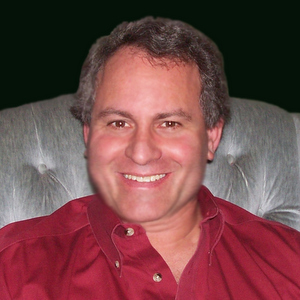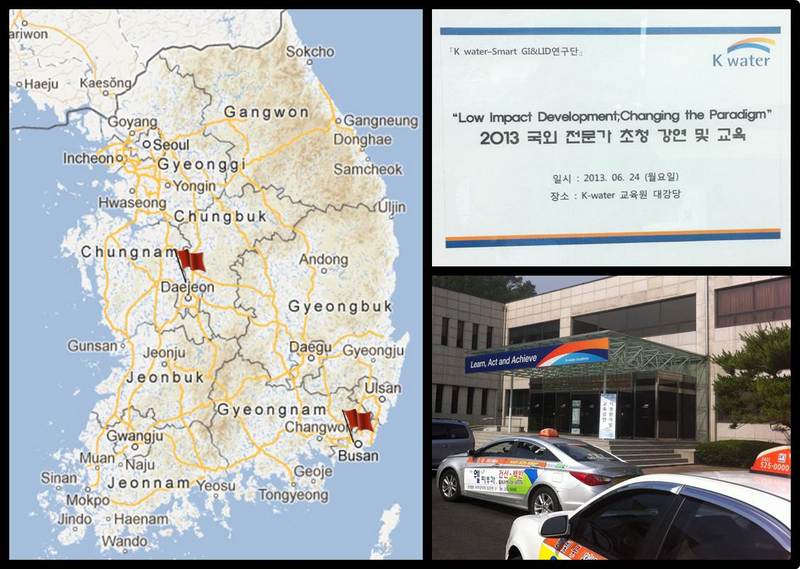________________________________________________________
I arrived in Busan, South Korea at 6:20 pm on Sunday for a Monday presentation on Low Impact Development. I was invited to present by Dr. Hyunsuk Shin of Pusan National University. He is head of a five-year research project to advance low impact development (LID) approaches, design specifications, codes, and regulations to implement LID in South Korea.
The presentation was held at the Korea Water Resources Corporation (K-Water) headquarters, located in Daejeon, South Korea, which is 1.5 hours north of Busan by train.
The presentation covered issues faced with conventional development and stormwater management. It included what LID is and how to apply it, types of LID systems and design specifications, and case studies from the U.S. There was also discussion about changing the regulatory framework to implement LID, particularly the differences between a “top down” and “bottom up” approach.

The restaurant across the street from my hotel is using concrete pavers with grass in an outdoor dining area.
Much of the discussion centered on how LID could be incorporated into the existing urban environment. We discussed how LID, such as planters adjacent to building walls and biofiltration systems located in sidewalks, can address water quality problems. However, due to urbanized soils, infiltration may not be possible in some of South Korea’s highly urban areas.
We also discussed implementing LID on silt and clay loam soils, as it appears that these are the dominant soil conditions based on attendee questions. An additional concern is that the groundwater table is fairly shallow in some locations, only being 61 cm (24 in.) or so below the ground surface.
Sponsoring organizations included the Ministry of Land, Infrastructure and Transport; K-water Institute; Pusan National University; Korea Institute of Construction Technology; Korea Engineering Consultants Corporation; the Land and Housing Institute; and KAIA. Approximately 140 engineers and government employees attended the presentation, which was about eight hours long.
On Tuesday, I will be visiting Eco Delta City, which is currently used for agriculture but is the location for a new Korean city. A key aspect of the development plan for Eco Delta City is to incorporate LID into the city’s design from the ground up. Due to the extremely variable topography in South Korea — relatively flat land located between steep mountainous areas —most development consists of tall buildings with small footprints to maximize the use of available land. After visiting Eco Delta City, I will be touring the LID testing facility at Pusan National University.
















Hi Steve!
Looks like Korea might pave the way! How is their LID Testing facility look wrt the NH facility? With the soil apparently being of a different makeup, does that change Pollutant Loads and/or the basic process followed within APLETS? Also, does it appear that Korea may utilize more LID systems than are currently known? Looks like a great trip… Keep me posted on all new requirements. See ya when I see ya!
Mike,
The Korean LID research facility in being designed at the present time and construction is slated to start later this year. At the present time it is planned to evaluate different types of permeable pavements, and bioretention systems with runoff from adjacent impervious areas with regard to water quality and volume issues. The soils in South Korea are predominately silt and clay loams which will have slower natural infiltration rates than many of the soils in the northeast US but would appear to be similar to clay soils found in parts of Texas and the mountains of North Carolina. At the current time, they are conducting water quality monitoring of impervious areas to begin to assess the pollutant loads from these areas. I believe the data will be very interesting as South Korea get the majority of their total annual rainfall in just two months (July and August) where around 27″ of rain can occur. The monthly rainfall amounts significantly drop off during the rest of the year. I think the pollutant concentrations will be lower during the time of high rainfall as more runoff will dilute the concentrations and the concentrations will be higher, perhaps significantly otherwise as more pollutants will accumulate on an impervious surface between rainfall events.
At least initially, the LID systems being used in the US will be used here, but modifications to the designs will likely be necessary to address soil and slope issues. Also, urban retrofits will be more of a challenge due to space limitations in the city.